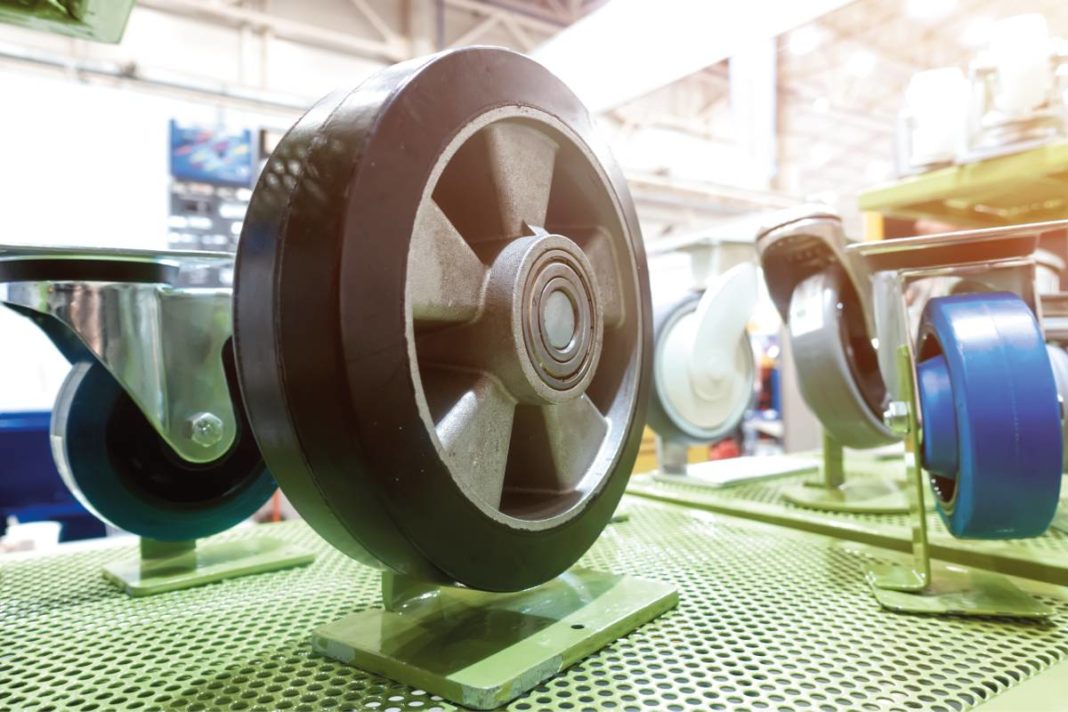In the delicate universe of mobility and engineering, the contribution of a caster wheel configuration to performance is important, if not imperative. Despite its looks, the caster wheel would be regarded as a very important part of quite a lot of equipment, ranging from an ordinary everyday chair used in the office to really complex industrial devices. Caster wheel setup vastly affects the maneuverability, stability, capacity to bear load, and the wear and tear of the whole system. This paper investigates a study where the minor components of the caster wheel may give rise to great differences in performance.
Understanding Caster Wheels
It is simply a wheel that is offset and mounted parallel to the direction of movement on a fork, hence the easy 360-degree rotation. Most of the applications and industrial devices are found with casters, from furniture to shopping carts to office chairs.
A caster is designed to have a wheel, a fork, a swivel bearing, and a mount as all these basic parts contributing to its functionality. The material of the caster is directly proportional to the maximum capacity that the caster can withstand, whether it’s made of rubber, plastic, polyurethane, or metal.
Impact of Wheel Size and Material
Apart from these, size and material are two factors that greatly influence the performance of the caster wheels. Large-sized wheels can work across obstacles and irregular planes more effectively, which will improve the stability and load-bearing capacity. At the same time, small wheels will provide better maneuverability when spaces are restricted. Moreover, material selection is one of the most crucial parts of it. Rubber wheels, on the other hand, make it a point of absorbing shocks and reducing noise, which evidently makes them perfect for indoors. On the other hand, polyurethane wheels have higher carrying capacities for loads and stronger resiliency; they are hence better for application in more industrial situations.
Configurations for Maneuverability
Configuring caster wheels for optimal maneuverability involves balancing agility with stability.
It features beveled edges and 360-degree rotation swivel casters, offering unmatched maneuverability be it equipment that requires precision in positioning, including shopping carts, office chairs, amongst others. The tripod base and the wide, non-skid feet are meant to enhance stability, although this paves the way for flexibility and at times compromises its effectiveness. Swivel casters combine with rigid casters to provide greater stability and are often used to balance the setup when used in carts and industrial equipment.
Swivel vs. Rigid Casters
The choice of swivel and rigid casters depends on the need for any particular application. The swivel casters offer a smooth move in many directions at the cost of some stability, while rigid casters compromise some degree of stability, gaining maneuverability.
Four-Wheel vs. Three-Wheel Configurations
Such a three-wheel configuration perfectly maneuvers in very tight spaces. This is because it perfectly undertakes sharp turns in the most constrained environments, such as warehouses, with a single swjsonivel caster located at the front.
On the contrary, the four-wheel setting distributes weight across all the wheels equally and provides more stability and load-carrying capability, and is, therefore, best for heavy applications.
Load Distribution and Weight Capacity
Caster wheel arrangement also dictates load distribution, directly impacting the equipment’s overall weight capacity.
With an offset configuration, as is the case for type C, it moves the wheels from the center of gravity. It enhances the stability, more so under uneven loads or on rough terrain; pretty common for outdoor applications like garden carts. On the other hand, the centered configuration is under the center of gravity and in direct alignment with the two wheels to get maximum maneuver and easiness of steering. Being used indoors and under the category of hand trucks, this is preferred.
Impact on Wear and Tear
The type of caster wheels really does affect the life of the wheels and consequently damages the attached equipment. An improper setup might be manifestative of premature wear of wheels, an increase in friction, or even structural damage being caused to the equipment. Thus, the selection of proper wheel bearings is quite a matter of significance for smooth operation and durability. The sealed ball bearings include low friction and requirements for minimal maintenance, therefore being ideal for light to medium duty applications. The roller bearings take on more weight and are ideal for heavy-duty industrial applications.
Choosing the Right Wheel Bearings
The heart of the caster is the bearing, especially the sealing ball bearing type. They are more recommended for light applications because of the low friction and maintenance requirements. The roller types are the heaviest load-bearing qualities and are, therefore, recommended for the heaviest loads.
Regular Maintenance and Inspection
Whichever configuration of caster wheels is to be used, they should be kept maintained through inspection and care. This includes ensuring the ease of wear, clearing out bearings from debris, and lubrication of moving parts so that they maintain durability and full performance.
Conclusion
It is, therefore, determined from this effort that the caster wheel always gets configured in the critical determinants of the performance of vehicles, equipment, and machinery across the diverse domains. With this in mind, they make wheel size, material, and configuration choices accordingly—swivel versus rigid, or even four-wheel versus three-wheel setups, for example—based on their applications for meeting exact performance criteria. The right arrangement of caster wheels can improve, literally by leaps and bounds, the functionality and efficiency of a given space, whether it is the narrow aisles of a warehouse, supporting heavy loads at an industrial facility, or just rolling easily over an office. The new materials and designs being unveiled through advancing technologies carry a great potential for innovative configurations of the caster wheels, which may further raise performance and efficiency standards already set within this world of mobility and engineering.







